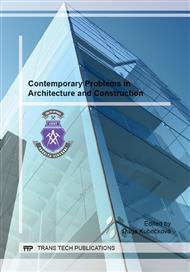[1]
Information on http: /www. ipcc. ch/pdf/assessment-report/ar4/syr/ar4_syr. pdf.
Google Scholar
[2]
J. Wichterlová, V. Roubíček, P. Pánek, Zachycování emisí z průmyslových zdrojů, Chemické listy. 102 (2008) 500-505.
Google Scholar
[3]
Information on http: /www. epa. gov/climatechange/Downloads/ghgemissions/US-GHG-Inventory-2013-Main-Text. pdf.
Google Scholar
[4]
Information on http: /www. eia. gov/forecasts/aeo/pdf/0383(2013). pdf.
Google Scholar
[5]
Information on http: /www. ipcc. ch/pdf/special-reports/srccs/srccs_wholereport. pdf.
Google Scholar
[6]
J. Rolker, W. Arlt, Abtrennung von Kohlendioxid aus Rauchgasen mittels Absorption, Chemie Ingenieur Technik. 78 (2006) 416-424.
DOI: 10.1002/cite.200600017
Google Scholar
[7]
A.B. Rao, E.S. Rubin, A Technical, Economic, and Environmental Assessment of Amine-Based CO2 Capture Technology for Power Plant Greenhouse Gas Control, Environ. Sci. Technol. 36 (2002) 4467–4475.
DOI: 10.1021/es0158861
Google Scholar
[8]
F. Yi et al. Modeling and experimental studies on absorption of CO2 by Benfield solution in rotating packed bed, Chemical Engineering Journal. 145 (2009) 377–384.
DOI: 10.1016/j.cej.2008.08.004
Google Scholar
[9]
Information on http: /www. digitalrefining. com/data/articles/file/1028234018. pdf.
Google Scholar
[10]
P. Wassercheid, A. Stark, Handbook of Green Chemistry: Green Solvents, WILEY-VCH, Weinheim, (2010).
Google Scholar
[11]
Information on http: /www. ccsreg. org/pdf/CCSReg_3_9. pdf.
Google Scholar
[12]
Information on http: /uicgroupecho. wikispaces. com/file/view/B_0308e_Rectisol. pdf.
Google Scholar
[13]
Information on http: /www. digitalrefining. com/data/articles/file/1312419751. pdf.
Google Scholar
[14]
M. Al-Juaied, G.T. Rochelle, Absorption of CO2 in Aqueous Diglycolamine, Ind. Eng. Chem. Res. 45 (2006) 2473–2482.
DOI: 10.1021/ie0505458
Google Scholar
[15]
L. Dubois, D. Thomas, CO2 Absorption into Aqueous Solutions of Monoethanolamine, Methyldiethanolamine, Piperazine and their Blends, Chemical Engineering & Technology. 32 (2009) 710-718.
DOI: 10.1002/ceat.200800545
Google Scholar
[16]
J. Huang, T. Rüther, Why are Ionic Liquids Attractive for CO2 Absorption? An Overview, Australian Journal of Chemistry. 62 (2009) 298-308.
DOI: 10.1071/ch08559
Google Scholar
[17]
P. Wassercheid, T. Welton, Ionic Liquids in Synthesis, WILEY-VCH, Weinheim, (2003).
Google Scholar
[18]
A. Ramalingam, T. Banerjee, Prediction and Validation of Carbon Dioxide Gas Solubility in Ionic Liquids at T=298K and Atmospheric Pressure using Quantum Chemical Approach, Chemical Product and Process Modeling. 6 (2011) 1-27.
DOI: 10.2202/1934-2659.1576
Google Scholar
[19]
E. Torralba-Calleja, J. Skinner, D. Gutiérrez-Tauste CO2 Capture in Ionic Liquids: A Review of Solubilities and Experimental Methods, Journal of Chemistry. 2013 (2013) 1-16.
DOI: 10.1155/2013/473584
Google Scholar
[20]
J. Jacquemin et al. Low-pressure solubilities and thermodynamics of solvation of eight gases in 1-butyl-3-methylimidazolium hexafluorophosphate, Fluid Phase Equilibria. 240 (2006) 87-95.
DOI: 10.1016/j.fluid.2005.12.003
Google Scholar
[21]
J. Jacquemin et al. Solubility of carbon dioxide, ethane, methane, oxygen, nitrogen, hydrogen, argon, and carbon monoxide in 1-butyl-3-methylimidazolium tetrafluoroborate between temperatures 283 K and 343 K and at pressures close to atmospheric, The Journal of Chemical Thermodynamics. 38 (2006).
DOI: 10.1016/j.jct.2005.07.002
Google Scholar
[22]
J-H. Yim et al. Measurement of CO2 Solubility in Ionic Liquids: [BMP][Tf2N] and [BMP][MeSO4] by Measuring Bubble-Point Pressure, J. Chem. Eng. Data. 56 (2011) 1197-1203.
DOI: 10.1021/je101100d
Google Scholar
[23]
Y. Chen et al. Solubility of CO2 in imidazolium-based tetrafluoroborate ionic liquids, Thermochimica Acta. 441 (2006) 42-44.
DOI: 10.1016/j.tca.2005.11.023
Google Scholar


